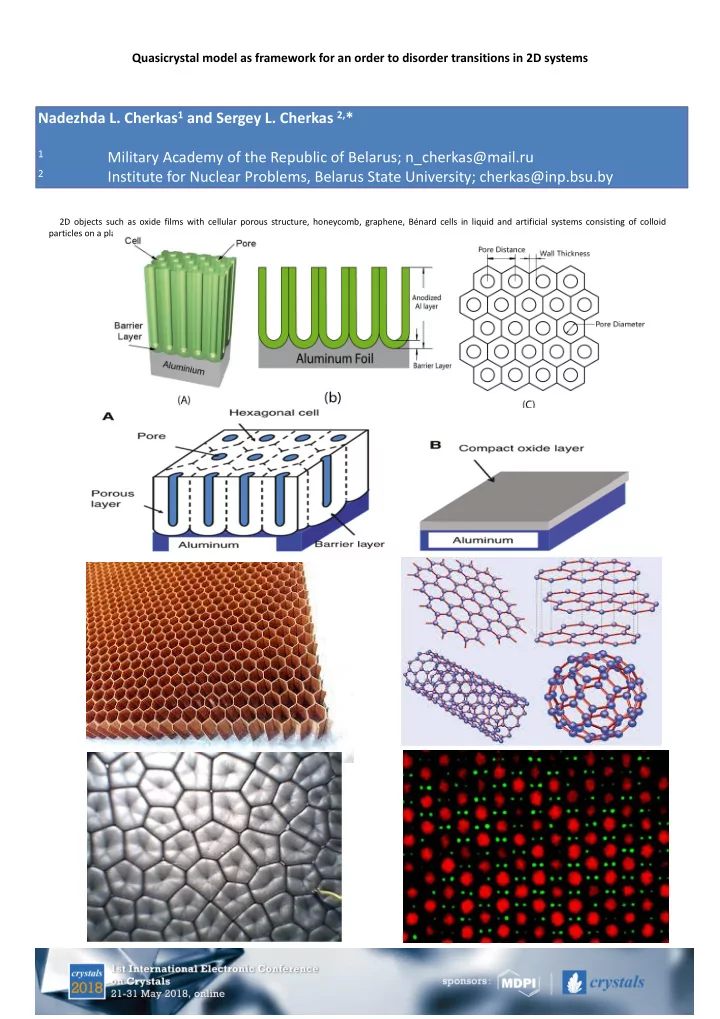

Quasicrystal model as framework for an order to disorder transitions in 2D systems Nadezhda L. Cherkas 1 and Sergey L. Cherkas 2, * 1 Military Academy of the Republic of Belarus; n_cherkas@mail.ru 2 Institute for Nuclear Problems, Belarus State University; cherkas@inp.bsu.by 2D objects such as oxide films with cellular porous structure, honeycomb, graphene, Bénard cells in liquid and artificial systems consisting of colloid particles on a plane
Radial distribution function for porous aluminum oxide layer. A binary distribution function of the pore density distribution was calculated by the formula N N g ( ) 2 2 N 1 ( ) d , where is the number of pores in the region between the circles of radii and whereas is the number of pores in the sample. The N N N N /( 1) correction factor takes into account the fact that the selected pore cannot be situated within its environment. g W ( ) Radial distribution function related to the function by the expression ( ) W ( ) g ( )/ n 0 is usually used, where n 0 is the average surface density of pores in the sample. ( a ) (b) Figure 1. ( a ) Photograph of the sample of porous aluminumoxide layer. Circles around pore centers are plotted; ( b ) Array of pore centers obtained by a parallel translation of the pore centers in the initial array along the coordinate axes and the diagonals of the sample. The region containing pore centers in the starting sample is selected by a rectangle. The two-particle distribution function g(r) is a sum of the Dirac delta-function terms: ρ ρ ρ (2) g ( ) ( ), i i where represents a two-dimensional delta-function by Dirac, is position vectors of particles in an ideal lattice. The particles are situated in the ρ ρ (2) ( ) i nods of the crystalline lattice. (a) (b) (c) Figure 2. The two-dimensional lattices: hexagonal (a), square (b), triangular (c). The radial distribution function 2 2 1 ( ) i i W ( ) 1 2 ( ) N exp ( D ) I i i min 0 2 2 n 2 ( ) ( ) i 0 2 2 ( ) n 0 exp ( D ) I d , min 0 2 2 n 2 ( ) ( ) 0 D min where summation is performed not over the nods, but over coordination circles on which the nodes are situated and, N is the number of the nods laying on each i -th coordination circle. Figure 3. Radial distribution function of pores in porous aluminum oxide: experimental sample (solid curve) and our calculation (dashed curve).
Hard disks in a plane. Conclusions Radial distribution function parameterization, based on the quasicrystall model is presented. This parameterization describes on the same footing as porous aluminum oxide, so as 2-D hard disk fluid. The quasicrystall model is based on the two effects: the first one is the vacancy type defects formation and the second one is the destroying of the crystal lattice by the smearing. The successes of this paramerization shows that even liquid of the hard disks contain features of a crystal. The model will serve as a tool for the description of the phase transitions in the 2-D fluids. From the other hand, it could be base for variational methods, because the parameters describing spreading, defects probability and lattice constants could be found by minimization of some functional.
Recommend
More recommend